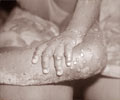Non-Latino white children seeking treatment for viral infections are about twice as likely to receive an antibiotic unnecessarily compared to Latino children.

‘Doctors prescribe antibiotics unnecessarily to non-Latino white children seeking treatment viral infections despite the clear public health risk of antibiotics.’





The research, led by Monika K. Goyal, M.D., M.S.C.E., director of research in the Division of Emergency Medicine at Children's National Health System, was published online Sept. 5, 2017 in Pediatrics and echoes similar racial and ethnic differences in treating acute respiratory tract infections in the primary care setting. "It is encouraging that just 2.6 percent of children treated in pediatric Emergency Departments (EDs) across the nation received antibiotics for viral acute respiratory tract infections since antibiotics are ineffective in treating viral infections," Dr. Goyal says. "However, it is troubling to see such persistent racial and ethnic differences in how medications are prescribed, in this case in the ED. In addition to providing the best evidence-based care, we also strive to provide equitable care to all patients."
Acute respiratory tract infections are among the most common reasons children are rushed to the ED for treatment, Dr. Goyal and co-authors write. Overprescribing antibiotics is also rampant for this viral ailment, with antibiotics erroneously prescribed for 13 percent to 75 percent of pediatric patients.
In the retrospective cohort study, the research team pored over deidentified electronic health data for the 2013 calendar year from seven geographically diverse pediatric EDs, capturing 39,445 encounters for these infections that met the study's inclusion criteria. The patients' mean age was 3.3 years old. Some 4.3 percent of non-Latino white patients received oral, intravenous or intramuscular antibiotics in the ED or upon discharge, compared with 2.6 percent of Latino patients and 1.9 percent of non-Latino black patients.
"A number of studies have demonstrated disparities with regards to how children of different ethnicities and races are treated in our nation's pediatric EDs, including frequency of computed tomography scans for minor head trauma, laboratory and radiology tests, and pain management. Unfortunately, today's results provide further evidence of racial and ethnic differences in providing health care in the ED setting," Dr. Goyal says. "Although, in this case, minority children received evidence-based care, more study is needed to explain why differences in care exist at all."
Advertisement
According to the study authors, future research should explore the reasons that underlie racial and ethnic differences in antibiotic prescribing, including ED clinicians eager to appease anxious parents as well as implicit clinical bias. Dr. Goyal recently received a National Institutes of Health grant to further study racial and ethnic differences in how children seeking treatment at hospital EDs are managed.
Advertisement
Source-Eurekalert











